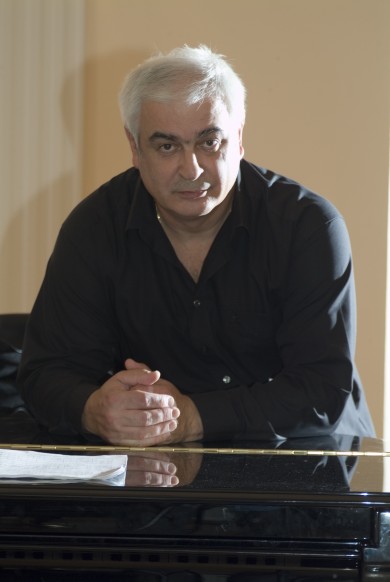Feltsman, Russian State Symphony provide mixed rewards at Kravis Center

Vladimir Feltsman performed Rachmaninoff with the Russian State Symphony Wednesday at the Kravis Center in West Palm Beach.
One of Sergei Rachmaninoff’s most popular concertos and perhaps his most problematical orchestral work comprised the major bill of fare at the season’s first Regional Arts Concert Series matinee Wednesday at West Palm Beach’s Kravis Center. The all-Russian artist roster brought conductor Valery Polyansky and the Russian State Symphony Orchestra with pianist Vladimir Feltsman.
Feltsman can be a frustrating artist. His technical competence and digital dexterity are a given. After many years on the concert stage, his articulation is still agile, every note clean and precisely weighted. When he plays the keyboard works of Bach, Feltsman’s pianistic command and attention to detail can pay musical dividends. The big romantic showpieces that Russian pianists are expected to play have never really been his forte and his interpretive choices can often be eccentric.
From the opening bars of Rachmaninoff’s Concerto No. 2 in C minor, the emotional temperature was cool and the music’s passionate and lyrical qualities were short changed. Feltsman’s sudden accelerated tempo at the onset of the first movement coda may have set a speed record. The pianist’s elegant traversal of the second movement Andante sostenuto sounded more like Chopin than Rachmaninoff. Feltsman’s light touch missed the darker underpinnings beneath the melodies but he impressively negotiated the big climaxes, cutting loose with a display of old fashioned, power-pounding bravura.
The opening of the finale was unconventionally slow and stiff, the music’s sweep and thrust seemingly coming to a halt. By contrast, the big romantic melody was played very fast. Much of Feltsman’s phrasing was angular, the piano tone hard edged. Far from the idiomatic depth of Garrick Ohlsson’s revelatory performance last season with the New World Symphony, Feltsman’s reading was fitfully stimulating but more often wayward.
The Moscow-based orchestra proved typical of Russian ensembles below the first-tier level of the Russian National Orchestra or the St. Petersburg Philharmonic. Wind playing was consistently raw with a nasal sounding, unpleasant vibrato. The orchestra’s strings are its major strength, exuding a big corporate sonority although sometimes lacking precision. (This was the orchestra’s second concert in less than twenty-four hours so tour fatigue may have contributed to problems.) The brass were sometimes raucous and ill balanced, producing more than a few fluffs in the opening Marche Slave of Tchaikovsky.
Leading without a podium, Polyansky seemed an uneven conductor. His tempo in the Tchaikovsky was funereal and he tended to drown Feltsman out in the concerto’s climaxes but he made a compelling case for Rachmaninoff’s Symphony No. 3 in A minor.
This infrequently played 1936 score is definitely the weakest of the five major works Rachmaninoff penned after emigrating to the West following the 1917 Soviet revolution. Much of the work’s melodic inspiration is uncharacteristically thin and the episodic finale can seem interminable. Rachmaninoff seems to be trying to repeat the successful formula of his Symphony No. 2 in a half-hearted manner.
Despite the symphony’s structural weaknesses, Polyansky imparted a sense of drama to the music. His fluid, spacious tempos and affectionate shaping of melodic lines seemed almost operatic. Throughout the first movement, Polyansky sustained the intensity, the final chords chilling. A strong horn solo commenced the Adagio ma non troppo, the concertmaster contributing a solo laden with thick vibrato. The violins produced a particularly rounded sonority and Polyansky brought color and excitement to the martial section, the percussion playing colorful and strongly forward.
Just when it seemed the conductor had brought the orchestra to exceed its capabilities, a wavery flute intruded and there was a wild scramble at the onset of the finale and continually coarse sounds from the brass. Polyansky managed to set a quick pace and hold the diffuse movement together.
The conductor was continually recalled to the stage and offered two balletic encores. The “Spanish Waltz” from Glazunov’s Raymonda ballet had plenty of vigor but the strings playing was ragged. Polyansky vividly brought off the impish, satirical spirit of “The Drayman’s Dance” from Shostakovich’s The Bolt. In a final burst of showmanship, he walked off the podium, leaving the orchestra to complete the piece minus conductor.
The Regional Arts Concert Series continues with the Takács Quartet playing works by Haydn, Debussy and Beethoven 8 p.m. December 11 at the Kravis Center in West Palm Beach. kravis.org; 800-572-8471.
Posted in Performances
Leave a Comment
Thu Nov 20, 2014
at 11:37 am
No Comments
